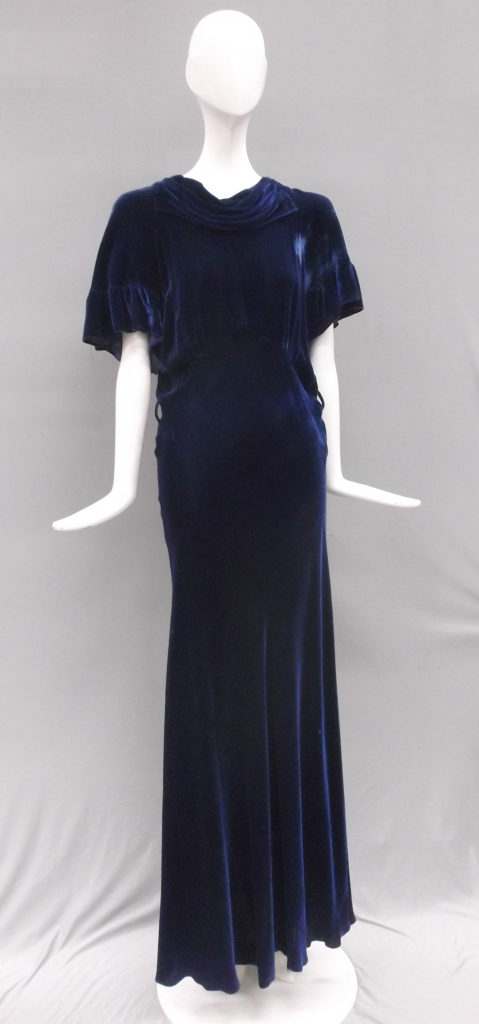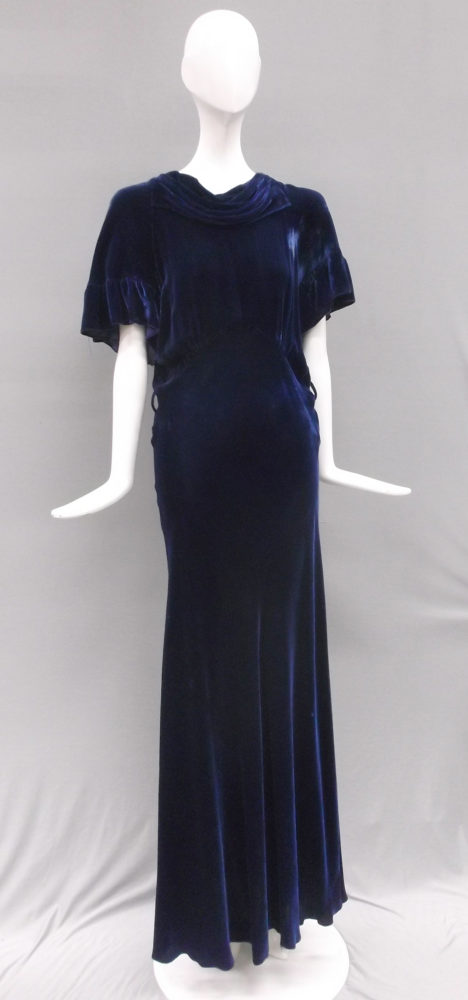Brides in blue?

This 1930’s wedding gown was worn by Ann Devlin and can be viewed on the fourth level of the Family Life Center in the showcase.
This week, we have a wedding dress with a beautiful history. Donated by Owen and Kathie Anderson, the dress was originally worn by Ann Devlin in her marriage to Arthur Anderson in 1936. If it isn’t already obvious, the most interesting feature of this wedding dress is the color. Navy blue is not typically thought of as a color somebody would wear on their wedding day. The Emily Reynolds Collection has the pleasure of having two blue velvet wedding gowns in the collection, both wedding dresses dating back to the 1930s.
The style of the wedding dress is common in the 1930s. Due to the influence of the Golden Age in Hollywood, the dress contains a draping neckline, short kimono sleeves, and the most recognizable feature that tells it’s from the 1930’s its gathered waist. By the time of the wedding in 1936, Hollywood had already produced King Kong, the original Scarface, and Bride of Frankenstein. Throughout the films, actresses can be seen wearing dresses similar to the style of Ann’s wedding gown.
The recently married couple, Ann Devlin and Arthur Anderson studied at Mayville State Teachers’ College together. They then followed careers in education at rural schools across Griggs County. By 1951, the two had become the parents of Owen and decided that the best decision for the family was to move to the farm Arthur grew up at.
During their time, they continued to gain land and were then known as prominent farmers in the region. With farming being the family business the farm was passed down to Owen and his wife Kathie, a University of North Dakota student. The family’s farm was known to many as the “O. L. Anderson Farm” and united the family as well as the community.
Now getting to the part that you’re probably most curious about, the color. The blue velvet of the dress played a dual role. On one hand, it was a unique color a bride could wear on her big day; on the other, it was a dress that could be worn beyond her wedding day. Looking back at history, the Midwest in the United States suffered financial and physical damage as a result of the Great Depression. The economic downturn experienced by the rest of the nation hit the Midwest, but it also faced the Dust Bowl. The Dust Bowl destroyed crops on fields and threatened the health of many citizens.
During this financial straining period, a blue velvet dress could be worn on multiple occasions rather than just on one day. The significance of this dress goes beyond the typical importance of what a wedding gown means but, conveys how the economy directly impacted people and their choices (and continues to do so). Because the collection contains two blue velvet wedding dresses, we can infer it was popular to have a dress that made a bride look stunning on her wedding day, along with other formal events.
